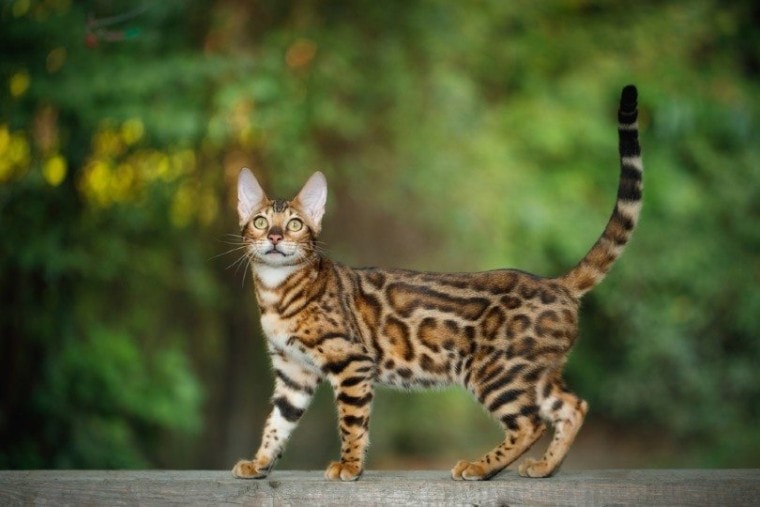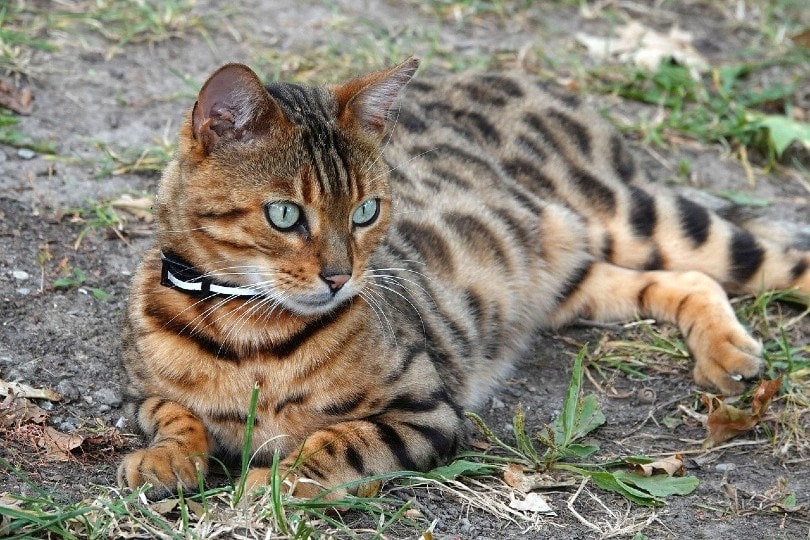
Click to Skip Ahead
As one of the most beautiful and popular purebred kitties, the spotted Bengal cat might remind you of a wild feline, such as a leopard. However, you don’t have to worry about a Bengal cat reaching the same size as a wild feline.
Adult female Bengal cats are usually about the size of the average domestic shorthair cat, about 6-12 pounds. Males typically grow bigger and heavier, reaching an average adult weight of 9-15 pounds.
Of course, every cat is different, and several factors can impact how big a Bengal cat gets, as you’ll learn in this article. We’ll also cover how to measure the size of your Bengal cat and how to choose the proper diet to maintain a healthy weight.
Facts About the Bengal Cat

Bengal Cat Size and Growth Chart
| Age | Weight Range | Height Range | Length Range |
| 8 weeks | 2-4 lbs | 6-8’’ | 7-9’’ |
| 3 months | 4-5 lbs | 7-9’’ | 8-10’’ |
| 6 months | 6-12 lbs | 8-10’’ | 10-12’’ |
| 9 months | 8-15 lbs | 10-12’’ | 12-14’’ |
| 1 year | 10-15 lbs | 11-14’’ | 14-16’’ |
| 2 years | 10-15 lbs | 13-15’’ | 16-18’’ |
When Does a Bengal Cat Stop Growing?
Bengal cats are quite different from other breeds of domestic cats. They are much larger overall than your standard tabby. When they reach maturity, they tend to have long, muscular bodies with sleek profiles.
These cats usually stop growing when they reach 18 months to 2 years of age. However, some Bengal cats can continue to grow for an additional year, but that is very rare. By 2 years, a Bengal cat will weigh around 15 pounds and can grow up to 15 inches in height.
Within 2 years, your Bengal cat will grow rather quickly. But no need to worry. Just because they look like a leopard doesn’t mean they’ll reach that size!

When Do I Know My Bengal Has Reached Maturity?
When your Bengal cat reaches 2 years of age, you can consider it mature. After this, they generally stop gaining weight (aside from feeding or glandular issues) or growing taller.
But even though they’ll have reached their maturity, your Bengal cat will remain very active and bouncy. They will continue to play with you as usual, and they never outgrow their kitten-like behaviors. Many owners love them because of this fact alone.
They’re such a fun cat to have at home!
Factors Affecting the Size of Bengals
Some factors affect Bengal cat size, and one of them is the method of cross-breeding carried out. When a Bengal cat is not of the purest breed, it may not reach the maximum weight and height expected of the purebred one. Proper feeding is also important for Bengal cats to remain healthy and active. If they are not getting the right amounts of protein, vitamins, and minerals from their diet, they might not reach their ideal size.
Ideal Diet for Maintaining a Healthy Weight
To keep your Bengal cat at a healthy weight, you need to ensure they get consistent exercise and eat the right diet. The ideal diet for maintaining a healthy weight will vary based on your cat’s age, size, activity level, and chronic medical conditions.
Healthy Bengals can eat any nutritionally balanced diet formulated for cats. Commercial canned or dry diets are good choices because they’re required to be complete and balanced for cats. Ask your vet to help you choose a diet and calculate how many calories your Bengal should eat daily to reach or maintain a healthy weight.

How to Manage a Cat the Size of a Bengal
The Bengal cat is extremely active and athletic. And this is mainly how they maintain their own weight. However, they’re not the smallest breed around and can be problematic for those living in a small space. They definitely require adequate space in order to exercise and run around.
The ideal home for Bengal cats is a house with an enclosed backyard and several trees as they love to play in tree branches just like wild cats do.
Bengal cats that do not get enough exercise might start gaining unwanted weight. This is not healthy and can lead to eventual obesity.
How to Measure Your Bengal Cat
Weighing your Bengal cat at home is easy with a digital bathroom scale and pet carrier. Place the carrier on the scale and zero out or tare the weight. Put your Bengal cat inside without removing the carrier and read the resulting weight. Alternatively, you can weigh the carrier, then the carrier with your cat inside, and subtract the weight of the carrier. Similarly, you can weigh yourself and then weigh yourself holding your cat and subtract your weight.
To measure your Bengal cat, use a standard sewing tape measure. For the length, measure from the nose to the base of the tail. For the cat’s height, measure from the ground to the top point of the shoulders.
Conclusion
Bengal cats are some of the most fun cats to have around. They can make great companions as they love lots of attention. However, they may not be the best choice for a cuddly lap cat. The Bengal cat is the best option for sporty individuals or those who like to be outdoors.
If you are thinking about getting a Bengal cat as a pet, make sure you have enough space for it at home. And since it doesn’t like to be left alone for long hours at a time, ensure your schedule matches up with their needs.
Featured Image Credit: Seregraff, Shutterstock








